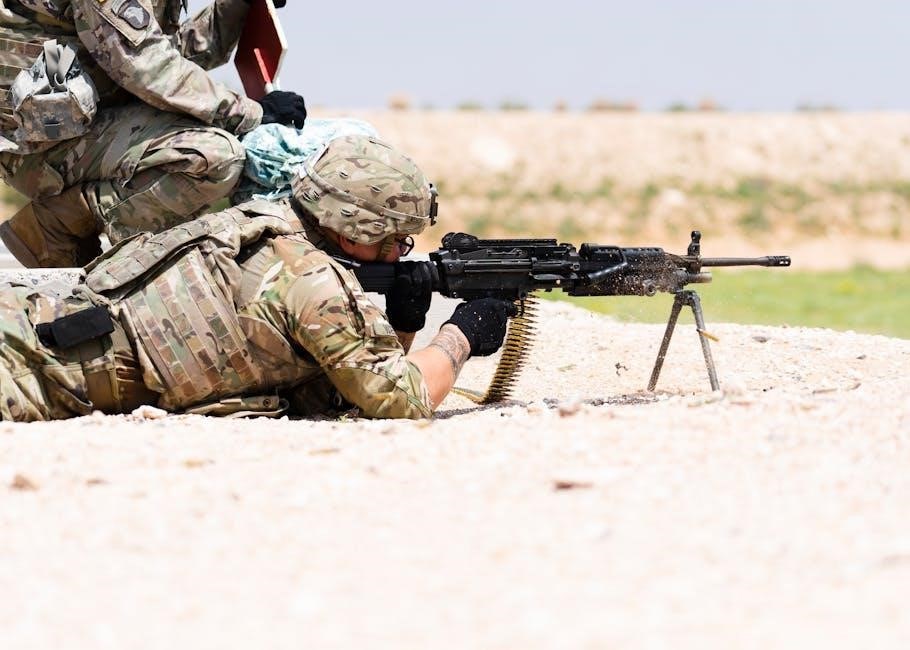The Allied victory in World War II was a collective achievement, driven by unity, economic might, strategic planning, and societal cohesion, making their triumph inevitable.
Overview of World War II and the Allied Victory
World War II was the largest conflict in human history, involving over 50 nations and fought on multiple fronts. The Allies, comprising the United States, the Soviet Union, Britain, and others, ultimately triumphed due to a combination of economic might, strategic coordination, and societal unity. The war marked a turning point in global history, showcasing the importance of industrial capacity, intelligence, and leadership. The Allies’ ability to mobilize resources, innovate technologically, and maintain cohesion despite differences proved decisive. Their victory reshaped the world order and underscored the power of collective effort in achieving monumental goals.

The Economic Might of the Allies
The Allies’ industrial capacity and resource mobilization were pivotal, with the United States emerging as the “Arsenal of Democracy,” producing vast quantities of weapons and supplies.
Industrial Production and Resource Mobilization
The Allies’ ability to mobilize resources and ramp up industrial production was a cornerstone of their success. The United States, in particular, became the “Arsenal of Democracy,” manufacturing vast quantities of weapons, tanks, and aircraft. This industrial prowess allowed the Allies to supply not only their own forces but also those of their partners, ensuring a steady flow of materiel to the front lines. Britain and the Soviet Union also made significant contributions, with Britain focusing on strategic resources and the Soviets leveraging their vast industrial base. This collective effort overwhelmed the Axis powers’ capacity to produce and sustain their war efforts, ultimately tipping the balance in favor of the Allies.
The Role of the United States as the “Arsenal of Democracy”
The United States emerged as the “Arsenal of Democracy,” playing a pivotal role in the Allied victory. Through unprecedented industrial output, America supplied vast quantities of weapons, vehicles, and supplies to its own forces and those of its allies. The Lend-Lease Act further amplified this effort, providing critical aid to nations like Britain and the Soviet Union. This industrial might not only bolstered the Allies’ military capabilities but also ensured a steady supply of resources, enabling them to maintain momentum on multiple fronts and ultimately overpower the Axis powers. America’s contribution was instrumental in shifting the war’s outcome.
The Soviet Union’s Industrial Base and Manpower
The Soviet Union’s immense industrial base and vast manpower were crucial to the Allied victory. Despite suffering heavy losses, the USSR mobilized millions of soldiers and relocated factories eastward to escape Nazi advances. This allowed for continuous production of tanks, artillery, and ammunition, which were pivotal in battles like Stalingrad and Kursk. The Soviet Union’s ability to absorb staggering casualties while maintaining industrial output made it a cornerstone of the Allied effort, enabling it to push back Axis forces and secure decisive victories on the Eastern Front, ultimately contributing significantly to the defeat of Nazi Germany.
Britain’s Economic Resilience and Strategic Resources
Britain’s economic resilience and strategic resources significantly contributed to the Allied victory. Despite facing immense pressure, especially during the Battle of Britain, the UK maintained a robust industrial base, producing vital weapons and supplies. Its access to colonial resources and strategic locations, such as Gibraltar and Malta, enhanced its logistical capabilities. The British Empire’s global network also provided a steady supply of manpower and materials, bolstering the war effort. Additionally, Britain’s ability to withstand the Axis blockade and maintain economic stability ensured its continued participation, making it a steadfast pillar of the Allied coalition throughout the war.

Strategic Planning and Coordination
The Allies’ success stemmed from the development of a unified strategy, effective coordination among nations, and the leadership of key figures who aligned resources and objectives.
The Development of a Unified Allied Strategy
The Allies’ ability to create a unified strategy was pivotal in their success. By coordinating efforts across theaters, they maximized resource allocation and ensured a cohesive approach. This strategic alignment allowed them to address both European and Pacific fronts effectively, preventing the Axis powers from concentrating their forces. The development of this strategy involved extensive planning and cooperation, ensuring that military campaigns were synchronized to achieve overarching goals. This unity in strategy not only enhanced operational efficiency but also bolstered the Allies’ collective resolve, proving decisive in the war’s outcome.
Key Leadership Roles in Allied Success
The leadership of figures like Roosevelt, Churchill, and Stalin played a crucial role in Allied success. Their ability to coordinate strategies and maintain unity among diverse nations was instrumental. Roosevelt’s vision for a post-war order and Churchill’s unwavering resolve strengthened Allied cohesion. Stalin’s leadership, though authoritarian, mobilized the Soviet Union’s vast resources. Additionally, military leaders like Eisenhower and Zhukov ensured effective execution of plans. Their collaborative efforts in shaping and implementing strategies were vital in securing victory. Strong leadership at both political and military levels ensured the Allies remained aligned and committed to their shared goals, ultimately paving the way for their triumph.
The Importance of the Lend-Lease Act
The Lend-Lease Act was a pivotal program that enabled the United States to supply military aid to Allied nations without immediate payment. This initiative significantly bolstered the war efforts of countries like Britain and the Soviet Union, providing them with crucial weaponry, vehicles, and supplies. By strengthening Allied armies, the Act played a key role in countering Axis forces effectively. It not only solidified U.S. commitment to the Allies but also laid the foundation for post-war economic and political stability. This strategic support was instrumental in shifting the balance of power in favor of the Allies, ensuring their ultimate victory.

Military Victories and Turning Points
The Allies achieved pivotal victories in battles like Stalingrad, Midway, and D-Day, which shifted momentum, weakened Axis forces, and set the path to ultimate triumph.
The Battle of Stalingrad and Its Impact
The Battle of Stalingrad marked a pivotal turning point in World War II, showcasing the Soviet Union’s resilience and determination. Despite suffering immense casualties, the Soviets, led by General Georgy Zhukov, successfully encircled and defeated the German Sixth Army. This victory not only boosted Soviet morale but also halted the Axis advance on the Eastern Front. Stalingrad symbolized the beginning of the German army’s retreat and demonstrated the Allies’ growing strength. It remains one of the bloodiest battles in history, with over a million casualties, and was instrumental in shifting the war’s momentum in favor of the Allies.
The Battle of Midway, fought in June 1942, was a decisive naval engagement that shifted the balance of power in the Pacific. The United States, leveraging superior intelligence and radar technology, successfully intercepted and defeated a Japanese fleet aiming to capture the Midway Atoll. This victory prevented further Japanese expansion and secured a strategic advantage for the Allies. The loss of four Japanese aircraft carriers severely weakened their naval capabilities, while U.S. forces gained momentum, ultimately leading to the liberation of Pacific territories and paving the way for the Allied island-hopping campaign. Midway became a cornerstone of Allied success. The D-Day invasion on June 6, 1944, marked a pivotal moment in World War II, as Allied forces successfully landed on Normandy’s beaches, breaching Hitler’s “Fortress Europe.” Through meticulous planning, superior air and naval support, and the courage of troops, the Allies established a foothold in Nazi-occupied France. This operation, the largest amphibious assault in history, opened a new western front, diverting German resources and accelerating the collapse of the Third Reich. The liberation of Europe followed, culminating in the defeat of Nazi Germany and the eventual Allied victory. D-Day exemplified the Allies’ strategic and logistical prowess. The Allies leveraged groundbreaking technologies like radar and code-breaking to gain strategic advantages, while intelligence gathering and decryption efforts, such as cracking the Enigma code, proved decisive. The Allies’ ability to decipher enemy communications, notably through the cracking of the Enigma code at Bletchley Park, provided critical insights into Axis strategies. This intelligence allowed precise countermeasures, such as redirecting convoys to avoid U-boats and anticipating enemy troop movements. Code-breaking also enabled the Allies to prepare for key battles, like Midway, where foresight led to decisive victories. Intelligence gathering further bolstered strategic planning, ensuring resources were allocated efficiently and operations were executed with greater precision. These efforts significantly shortened the war and saved countless lives, exemplifying how intellect and technology became powerful weapons in achieving Allied success. Radar technology played a pivotal role in the Allied victory, providing early detection of enemy aircraft and missiles. The British developed the Chain Home system, enabling advance warning of Luftwaffe raids during the Battle of Britain. This allowed for efficient deployment of defenses, minimizing damage and saving lives. Radar also enhanced anti-submarine warfare, helping to protect vital supply convoys. Its integration with intelligence systems like code-breaking maximized strategic advantages. The Allies’ mastery of radar technology gave them a critical edge in air and naval battles, ensuring superior coordination and response capabilities throughout the war. This innovation was indispensable to their ultimate success. The Allies’ shared purpose and resilience fostered unity, boosting morale and enabling collective efforts. This cohesion strengthened their resolve to overcome adversity and achieve victory together. The Allied nations demonstrated remarkable unity, overcoming political and cultural differences to form a cohesive coalition. This unity was crucial in coordinating efforts, sharing resources, and executing strategies. Historic partnerships, like the Anglo-American alliance, played a pivotal role in maintaining solidarity. Mutual goals and the shared threat of Axis dominance fostered cooperation, enabling the Allies to present a united front. This collective resolve was key to their ultimate success, proving that unity amidst diversity could overcome even the most formidable challenges. Propaganda played a crucial role in sustaining public morale among the Allied nations, fostering unity and determination. Governments utilized radio broadcasts, posters, and films to disseminate messages of hope and resilience. Leaders like Churchill and Roosevelt delivered inspiring speeches, bolstering civilian resolve. The portrayal of the Axis powers as threats to freedom and democracy further galvanized support. High morale allowed societies to endure hardships, while propaganda highlighted Allied progress, reinforcing belief in eventual victory. This psychological warfare complemented military efforts, ensuring that the home front remained a pillar of strength throughout the conflict. The Allied victory in World War II was a collective triumph, rooted in unity, economic might, strategic planning, and societal resilience, ensuring their ultimate success over the Axis. The Allied victory in World War II was rooted in a combination of unity, strategic planning, and economic might. Their ability to mobilize resources, industrial production, and manpower played a crucial role. Strong leadership and coordination among nations ensured effective execution of plans. The Lend-Lease Act and societal cohesion further strengthened their resolve. Technological advancements, such as code-breaking and radar, provided strategic advantages. The collective effort, resilience, and moral unity ultimately led to the defeat of the Axis powers, highlighting the power of collaboration in achieving victory. These factors underscored the Allies’ ability to adapt and overcome unprecedented challenges.The Battle of Midway and Control of the Pacific
D-Day and the Liberation of Europe

The Role of Technology and Intelligence
Code-Breaking and Intelligence Gathering
The Development and Use of Radar Technology
Societal Cohesion and Morale
Unity Among Allied Nations
The Role of Propaganda and Public Morale
Summarizing the Key Factors in Allied Success




